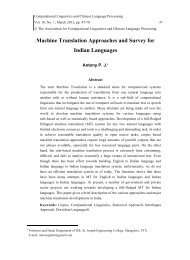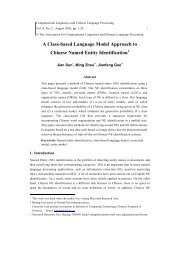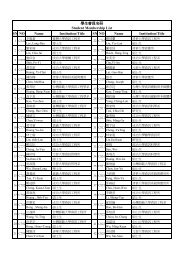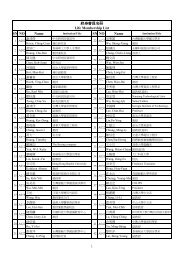Automatic Recognition of Cantonese-English Code ... - Aclclp.org.tw
Automatic Recognition of Cantonese-English Code ... - Aclclp.org.tw
Automatic Recognition of Cantonese-English Code ... - Aclclp.org.tw
Create successful ePaper yourself
Turn your PDF publications into a flip-book with our unique Google optimized e-Paper software.
282 Joyce Y. C. Chan et al.<br />
systems or sub-systems”. Different combinations <strong>of</strong> languages are found in code-switching,<br />
for examples, Spanish-<strong>English</strong> in United States, German-Italian and French-Italian in<br />
Switzerland, and Hebrew-<strong>English</strong> in Israel (Auer, 1998). In Taiwan, code-switching be<strong>tw</strong>een<br />
Chinese dialects, namely Mandarin and Taiwanese, has become common in recent years<br />
(Chen, 2004). Hong Kong is an international city where many people, especially the younger<br />
generation, are <strong>Cantonese</strong> and <strong>English</strong> bilinguals. <strong>English</strong> words are frequently embedded into<br />
spoken <strong>Cantonese</strong>. The switching <strong>of</strong> language tends to be intra-sentential, and it rarely<br />
involves linguistic units above the clause level. Hence, the term code-mixing is usually<br />
preferred (Li, 2000). In this case, <strong>Cantonese</strong> is the primary language, also known as the matrix<br />
language, and <strong>English</strong> is the secondary language, usually referred to as the embedded<br />
language (Halmari, 1997).<br />
<strong>Automatic</strong> speech recognition (ASR) is one <strong>of</strong> the key technologies in spoken language<br />
processing. An ASR system converts an input speech waveform into a sequence <strong>of</strong> words.<br />
Recently, ASR for multilingual applications has attracted great interest (Schultz & Kirchh<strong>of</strong>f,<br />
2006). In state-<strong>of</strong>-the-art ASR systems, the input speech is assumed to contain only one<br />
language and the language identity is given. These systems are not able to handle code-mixing<br />
speech, which differs significantly from monolingual speech spoken by native speakers. This<br />
calls for special consideration in the design <strong>of</strong> acoustic models, lexical and language models,<br />
and in the decoding algorithm.<br />
There have been <strong>tw</strong>o different approaches to code-switching or code-mixing speech<br />
recognition (Lyu et al., 2006; Chan et al., 2006). The first approach involves a language<br />
boundary detection (LBD) algorithm that divides the input utterance into<br />
language-homogeneous segments. The language identity <strong>of</strong> each segment is determined, and<br />
the respective monolingual speech recognizer is applied. LBD for mixed-language utterances<br />
was studied by Wu et al. (2006) and Chan et al. (2004). Language-specific phonological and<br />
acoustic properties were used as the primary cues to identify the languages. The second<br />
approach aims to develop a cross-lingual speech recognition system, which can handle<br />
multiple languages in a single utterance. The acoustic models, language models, and<br />
pronunciation dictionary are designed to be multi-lingual and cover all languages concerned.<br />
In Lyu et al. (2006), automatic recognition <strong>of</strong> Mandarin-Taiwanese code-switching speech<br />
was investigated. It was found that Mandarin and Taiwanese, both <strong>of</strong> which are Chinese<br />
dialects, share a large percentage <strong>of</strong> lexicon items. Their grammar was also assumed to be<br />
similar. A one-pass recognition algorithm was developed using a character-based search net. It<br />
was shown that the one-pass approach outperforms LBD-based multi-pass approaches. In You<br />
et al. (2004), a mixed-lingual keyword spotting system was developed for auto-attendant<br />
applications. The keywords to be detected could be in either <strong>English</strong> or Chinese.<br />
This paper presents a study on automatic speech recognition <strong>of</strong> <strong>Cantonese</strong>-<strong>English</strong>









